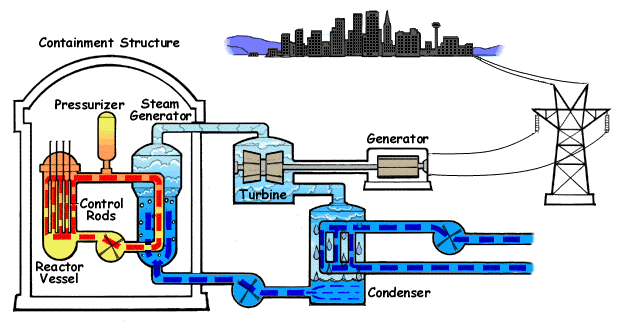The process that powers a nuclear power plant is nuclear fission.
While nuclear fusion is the process of fusing two or more lighter elements into
a larger one, such as that which happens in stars; nuclear fission is the
splitting of a large atom into two or more smaller atoms (Diffen). Although nuclear fusion produces a larger
amount of energy than fission, we do not currently have the technology to
overcome the barriers needed to attain it.
 |
| Nuclear Fission vs Nuclear Fusion (Duke Energy) |
While this topic may be quite new for some readers, I sadly
don’t have enough space to explain properly some of the elements I’ll
be discussing. If you want to know the basics about atoms and isotopes, or
would just like a small refresher click this link and check out the different
pages.
In a nuclear reactor, an element called Uranium is used as
the fuel. This element has a number of isotopes, with an isotope being the same
element, but with a different number of neutrons. Nuclear fuel consists of the isotopes U-238
and U-235, with the U-235 being the fissionable isotope. In the nuclear reactor,
neutrons are fired at the U-235 which make it become U-236 as the number of
neutrons have changed (NEI 2016). This makes the uranium unstable and causes it to split
apart into two new atoms and three neutrons, while also releasing the energy
that we collect. The three released neutrons can then split more uranium, which
in turn release more neutrons and so on. This creates a chain reaction which is
now self-sufficient and will carry on until the fuel is spent (WNA 2016). If you find any
of this confusing, check out the first page of this link which will hopefully
clarify any issues, or post a comment down below.
 |
| Nuclear Fission involving U-235 (BBC Bitesize) |
Now that all the nuclear science is out of the way, the rest
of a nuclear power plant is practically the same as a conventional plant that
burns coal, oil and natural gas. Energy from the reaction, which in our case is
the splitting of U-235, is used to heat up water to its boiling point which is
where it would normally be converted into steam (Darvill 2016). However, the pipes that
contain the water are pressurised, so the water stays in its liquid form. This
water is transported through another tank called a steam generator which
contains water under lower pressure. The heat is then transferred from
the heated water in the pipes to the water in the steam generator which boils
into steam as it is under lower pressure (Darvill 2016). This steam then turns a turbine which
turns a generator which then produces the electricity that we all know and
love. The steam is then condensed back
into water and returns to the steam generator to repeat the process. This can all be a bit much too follow, so
below is a gif showing the overall process and also a small video with an
explanation.
 |
| Nuclear Reactor Diagram (What is Nuclear) |
In the following weeks I shall be discussing success stories and disaster incidents of nuclear energy, starting with the Chernobyl disaster. If you have any questions about
today’s post, please do not hesitate to ask in the comments below, and I shall answer to
the best of my ability. I’ll also leave a video down below; it gives a brief
history of nuclear energy, its processes and has follow on videos of its pros
and cons that can be found at its end as well.
